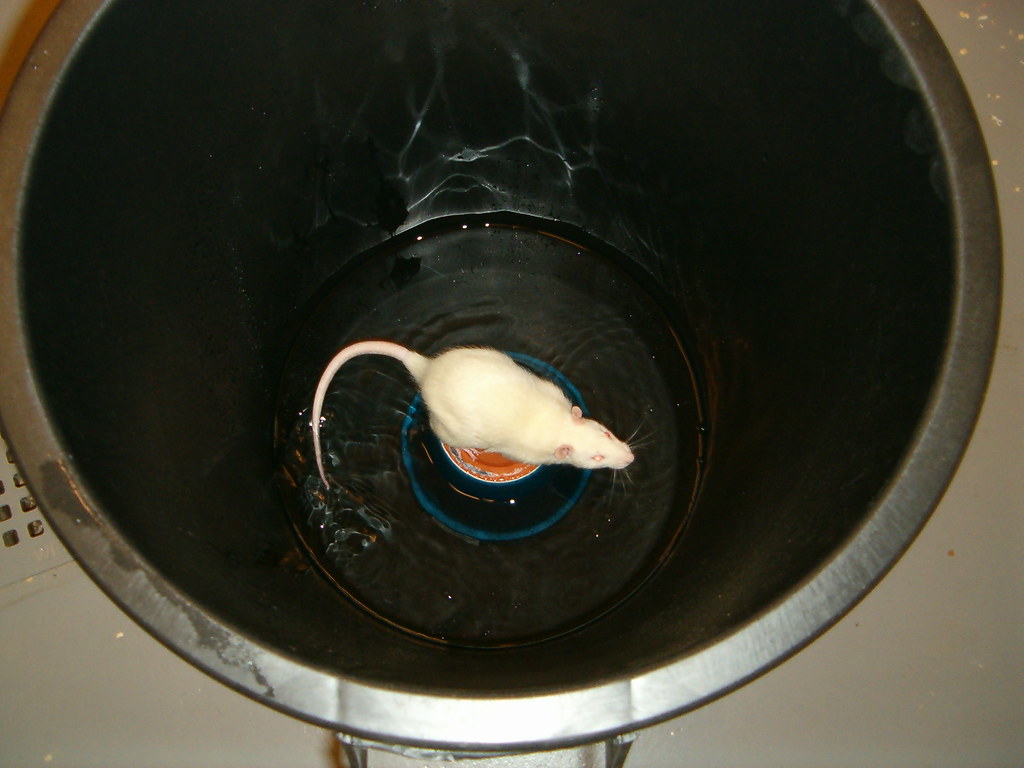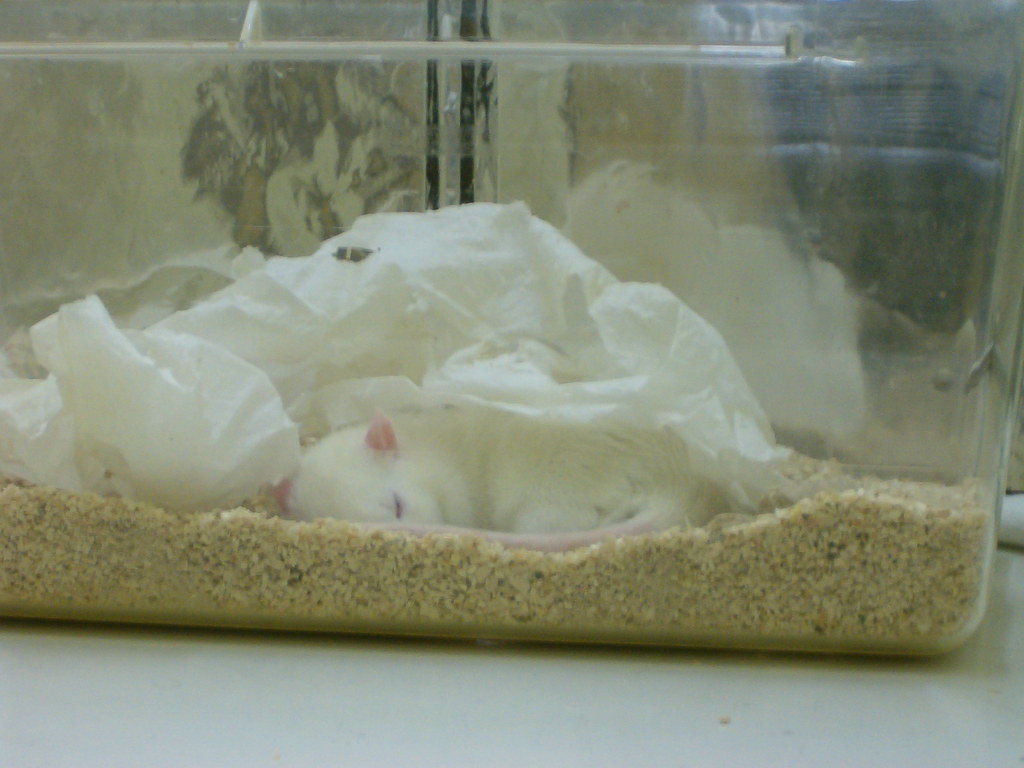.

View of West of Delhi (and air pollution). I think Delhi is one of the few big capitals with so few towers. Taken from Jama Masjit: photo by Jean-Etienne Minh-Duy Poirrier, 12 January 20116 October 2005
Hazy hazy but it already looks like this
All the time now, on
The tippy single platform
All the towers of the unreal
City have fallen or soon will be
Falling and there are to be no more dreams
Tired tired and would wish to sleep
The failing animal machine said
Falling into the water
Again
All the time now, on
The tippy single platform
All the towers of the unreal
City have fallen or soon will be
Falling and there are to be no more dreams
Tired tired and would wish to sleep
The failing animal machine said
Falling into the water
Again

Rat on the "single platform" aka "inverted flower pot", used for rodent REM sleep deprivation. The Flowerpot technique is used in sleep deprivation studies. It is designed to allow NREM sleep but prevent REM sleep. A laboratory rat is placed on top of an upside down flower pot which is placed in a bucket of water. While in NREM sleep the rat retains muscle tone so it can sleep on top of the flowerpot. When the rat enters REM sleep it will lose muscle tone and fall off the flowerpot into the water, then climb back up and re-enter NREM sleep. This rat is being deprived of restful REM sleep by a researcher using the single platform ("flower pot") technique. The water is within 1 cm of the small flower pot bottom platform where the rat sits. At the onset of REM sleep, either the rat will fall into the water only to clamber back to its pot to avoid drowning, or its nose will become submerged into the water, shocking it back to an awakened state: photo by Jean-Etienne Minh-Duy Poirrier, 6 October 2005

From inside the cage... OK, I'm observing rats with my IR-enabled camera. But how does it feel to be observed like that? I put my camera in the cage and waited for the rat to stop sniffing at it: photo by Jean-Etienne Minh-Duy Poirrier, 19 June 2006

Rat sleeping in its cage: photo by Jean-Etienne Minh-Duy Poirrier, 13 April 2006
Lion (Panthera leo), Olomouc Zoo: photo by SonNy cZ,4 June 2007
If a lion could talk, we could not understand him.
Ludwig Wittgenstein:
Philosophical Investigations, c. 1945-1949
I personally can see no reason for conceding mind to my fellow men and denying it to animals. […] I at least cannot doubt that the interests and activities of animals are correlated with awareness and feeling in the same way as my own, and which may be, for aught I know, just as vivid.
I personally can see no reason for conceding mind to my fellow men and denying it to animals. […] I at least cannot doubt that the interests and activities of animals are correlated with awareness and feeling in the same way as my own, and which may be, for aught I know, just as vivid.
Lord Russell Brain, 1st Baron Brain, author of the standard work of neurology Brain's Diseases of the Nervous System (1933), longtime editor of the homonymous neurological medical journal titled Brain, and President of the Royal College of Physicians, 1950-56: from "Presidential Address," in C.A. Keele and R.
Smith, eds., The Assessment of Pain in Men and
Animals, 1962

This is not exactly breaking news, but... modern life, of which life in the future must be imagined to be some sort of logical extension, is a pretty stressful deal, whether or not you are a sleep-deprived rat on a flowerpot in an experiment. And stress is not a helpful ingredient in the life of any living organism.
ReplyDeleteHaving had sleep problems pretty much forever, I found it all too easy to identify with the plight of the poor sleep-deprived Spague Dawley lab rat stranded on the Flowerpot, struggling to keep awake so as not to get splashed into the drink... again..
Bred for the purpose, of course, yet still a sentient creature, just like you and me, maybe.
The question of whether or not sleep deprivation is torture has been in and out of the news in recent years, re. its use (with humans) as an "interrogation technique".
E.g., this from the Sydney Morning Herald (3 October 2006):
"Debate about what is and what is not torture has raged since the US announced a ban on the practice as an interrogation technique.
"Mr Ruddock said banning torture could harm the war being waged by the West against Islamist militants.
"But Amnesty spokeswoman Nicole Bieske said sleep deprivation was torture.
"'We are fundamentally opposed to cruel, inhumane and degrading treatment of any person,'" she [said].
"Sleep deprivation, Ms Bieske said, was considered cruel but if used for prolonged periods of time it was torture.
"'At the very least it is cruel, inhumane and degrading. If used for prolonged periods of time it is torture.'"
But of course the issue of whether a Sprague Dawley lab rat or a terrorism suspect should be exempt from torture remains open to dispute.
Over the course of history there has been a certain amount of disagreement as to whether individuals of either category should be allowed to retain any rights at all, much less the right to remain exempt from torture.
Descartes famously "held" that animals are machines and that seems plausible enough if we also concede that Descartes -- and Descartes' God -- are likewise machines. But that's an awful lot of concession, in one fell swoop as it were.
Some years ago I had an acquaintance whose worldly belongings went with her wherever she went, in a shopping cart. The shopping cart had been modified to serve as a rat hotel on wheels. And in it dwelt two rats, named Sweet Thing and Beauty. This person went to some lengths to provide her rat companions with amenities. At night they slept with her, in her sleeping bag. It was a touching arrangement, really. But nothing lasts forever, and this applies with particular poignancy to the lives of the creatures of the streets. Still, they have their freedom. And the person and her rats did in time go their separate ways, of their own choosing. A choice a Sprague Dawley lab rat never gets to make, once the experiments are mercifully over and done with. For it, all ways lead to one destination. The disposal bin.
Sweet Thing: Rat
Not of course that rats have ever had an easy time of it, even before they began being bred for torture (manufactured for science might be another way to say this).
ReplyDeleteThe Sprague Dawley outbred strain of albino rats is the legacy of a firm of enterprising Wisconsin businessmen: the Sprague Dawley farms, later to become, ahem, the Sprague Dawley Animal Company .
But of course by 1925, when the Sprague Dawley model "went into production", the jolly sport of rat-baiting had been a staple of popular entertainment in all the cosmopolitan capitals of Europe, for a very long while.
The celebrated rat-killing Terrier Major, killing 100 rats in 8 minutes, 53 seconds (19th c.)
Ratting at the Paris Dog Show, c. 1870 (with mirrored walls)
The rat-pit, Lancaster, 1912
The rat-killing dogs of yesteryear, much like today's lab rats, were specialists, bred for the purpose. Some became superstars and mini-celebrities, their accomplishments reverently ticked-off like the stats of "our" sporting heroes.
A much-admired Bull-Terrier named Billy, for example, could "boast of" a particularly impressive list of career highlights in public "competitions":
Billy's career was crowned on 22 April 1823, when a world record was set with a hundred rats killed in five-and-a-half minutes. This record stood until 1862 when it was claimed by another ratter named "Jacko".
Billy continued on in the rat pit until old age reportedly with only one eye and two teeth remaining. The stuff of legend, celebrated in song and story.
Billy, the rat-killing dog, at his work (London, c. 1823)
Tom,
ReplyDeletesleep that knits up the raveled sleeve of care . . . till human voices wake us and we drown
5.4
edge of sun coming up above still black
ridge, waning white moon next to branch
in foreground, wave sounding in channel
differs from zero, which is
suggested by functions
momentum, i.e., second term
transferred, to matter
silver of sunlight reflected in channel,
cloudless blue sky to the left of point
If a lion could talk through the haze of the future, he would say, "Thanks, Steve, we needed that".
ReplyDeleteTom if I could spray soothing sleep waves all over your home I would
ReplyDeleteSleep and its Deprivation obviously overlaps with the previous Pain exploration and I must rush in with this breaking news: Tylenol has been shown to cut down on "existential angst" and fear of death (which surely would help someone sleep better)
http://www.psychologicalscience.org/index.php/news/releases/experiencing-existential-dread-tylenol-may-do-the-trick.html
If a rat could talk, he would probably say please give me pen and paper, I need to write write write about what is going on in this Haze. You have just given him those words, Tom. The paths of Pain quite naturally led us to the patio of Torture, and there is so much to say here, but.... there are those two very powerful phrases and I think it will take me all day to reflect on them (get over them?): For it, all ways lead to one destination. The disposal bin.
ReplyDeleteme gustan mucho los animales que hablan en El Principito y Las ovejas de Glennkill
ReplyDeleteInverted flower pots used as sleep deprivation devices, indeed! Whatever will these researchers think of next? Perhaps they should brush up on their Emerson.
ReplyDelete"failing" and "falling" - so here we are.
ReplyDeleteOne can't help but think of Sam Beckett with that last "again". An almost comic torment.
Well, I must admit I did feel a bit sad about the wee rat in the Beckettian predicament on the flowerpot.
ReplyDeleteIn one of the classic experiments in the field of sleep research, it was shown that rats, when totally deprived of sleep, would. after two or three weeks, drop dead.
And those probably felt like the longest two or three weeks in their wee lives.
On a somewhat cheerier note, there are always the cases of the wild animals who have at least a longshot chance of staying wild, one way or another:
D. H. Lawrence: Rabbit in the House
And Sandra, here's a nice bit on your sheep:
Three Bags Full: reviewed at The Guardian